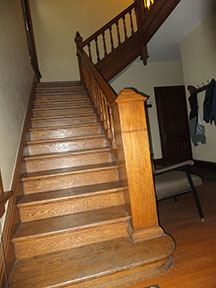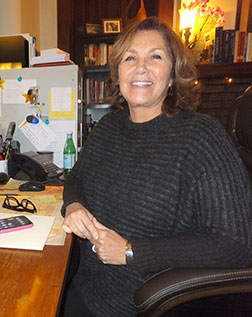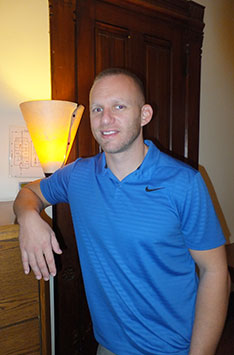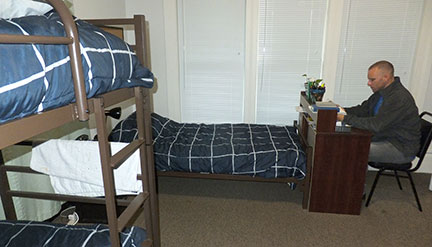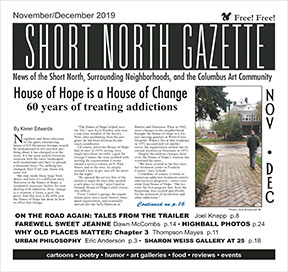
Columbus, Ohio USA
Return to Homepage www.shortnorth.com
House of Hope is a House of Change
60 years of treating addictions
by Karen Edwards
November/December 2019 Issue
Return to Homepage • Return to Features Index
PHOTOS © GUS BRUNSMAN III
House of Hope on Dennison Avenue in Victorian Village Neighbors and those who pass by the quiet, unassuming house at 825 Dennison Avenue, would be hard-pressed to tell you that anything about it has changed over the years. It’s the same stately Victorian mansion with the same landscaped, well-maintained yard they’ve passed a thousand times. No, nothing has changed, they’ll tell you. Same old, same old.
But step inside those large front doors, and here it’s a different story. Welcome to the House of Hope, a residential treatment facility for men dealing with addiction. Here, change is a constant, a focus, a goal, the point. And this year is the 60th year the House of Hope has done its best to effect that change.
“The House of Hope helped save my life,” says Kyle Harden, who was a one-time resident of the facility. Now, after graduating from the program, he has been hired as its outreach coordinator.
Of course, when the House of Hope had its start in 1959, saving lives might have been too lofty a goal for George Connor, the man credited with starting the organization. Connor owned a service station on N. Park Street, and at the time, he simply wanted a way to get men off the street for the night.
“He opened the service bay of his station at night for men who needed a safe place to sleep,” says Carolyn Ireland, House of Hope’s chief executive officer.
From Connor’s garage, the organization grew into a more formal, structured organization, and eventually moved into the Sells Mansion at Buttles and Dennison. Then in 1962, more changes to the neighborhood brought the House of Hope to a former nursing quarters at White Cross Hospital. When a fire at that residence in 1972 necessitated yet another move, the organization settled into its current location on Dennison in 1973.
Despite the address changes, however, the House of Hope’s mission has remained the same.
“We were created as the first alcohol treatment center in Franklin County,” says Ireland.
Columbus, of course, is home to numerous addiction treatment centers and recovery programs – some even older than House of Hope. “But we were the first program that, from the beginning, was created specifically for the treatment of alcoholism and other addictions.”
Changes in choice
Carolyn Ireland, House of Hope CEO Initially, the residents of House of Hope were primarily alcoholics. It makes sense. After all, the 1950s was the era rather romantically depicted by “Mad Men”– a time of elaborate barware, home bars, and James Bond’s famous “shaken, not stirred” line.
But times changed. The 1960s arrived with its “free love” allure, and, with it, a plethora of pot parties and acid trips. Marijuana and LSD were the drugs of choice during this rambunctious period.By the 1980s, crack cocaine had arrived. “Now,” says Ireland, “we are dealing with the opioid crisis.”
While prescription opioids, or pain killers, are still a prominent problem in Columbus, a 2017-2018 report issued by the Ohio Substance Abuse Monitoring Network shows prescription opioids are actually fourth in terms of substances abused. They are preceded by alcohol, marijuana, and heroin/fentanyl. The report states that community professionals and others who participated in the study said the street availability of opiates has decreased recently, which may account for the study’s findings.
Still, says Ireland, it doesn’t matter what the “drug de jour” may be. “We’re not here to treat a specific drug. We’re here to treat the disease of addiction.”
While a term like “addictive personality disorder” is tossed around rather loosely, it has been studied for years by those both in the medical and psychological fields. It’s not a formal medical condition, per se, but it is an informal way to describe the kind of personality traits that can lead to a higher risk of addictions – traits like lying, manipulating, acting impulsively, even criminally.
Just ask Harden
“I was in trouble with the law,” he says. “The court told me, go to jail or pick a treatment program,” says Harden. “That’s what led me to House of Hope.”
Kyle Harden, House of Hope Outreach Coordinator Harden can remember the exact date he walked through the front doors of that sturdy mansion that never changes. It was October 19, 2017. “I was an active addict for 12 years,” he says, fighting addictions to both alcohol and drugs. He had been in and out of various treatment centers with varying rates of success. Then he suffered an injury to his back. “I had four back surgeries over three years, and I became addicted to pain killers,” Harden recalls. This time, he went to House of Hope.
“I knew about it through some of my other resources,” he says. By the time he reached House of Hope, he adds,” I was desperate for help.”
It’s not unusual for addicts, like Harden, to return for treatment. Recidivism is a common problem in treating addictions and can lead to a vicious cycle of abuse, rehabilitation, relapse, abuse.House of Hope model
House of Hope, however, tries to change that pattern in several ways:
1. Residential treatment
The men who check into the house at 825 Dennison Avenue are more than likely going to be there for six months. The stay might be shorter or longer, depending on the individual, but the commitment is generally for six months, says Ireland. (And yes, House of Hope has a long waiting list.) Once inside, once accepted to the program, recovery becomes the residents’ primary focus while they are there.
“They don’t work or worry about paying bills or handling other stress factors,” says Ireland.
No job? Then how can they pay for their treatment? In fact, most of them don’t. Clients pay for their treatment according to a sliding scale, and most face few if any charges for their care. That’s due to a couple of factors. House of Hope is funded by the Franklin County ADAMH Board, the Ohio Department of Alcohol and Drug Addiction Services, the Franklin County Department of Jobs and Family Services, and by private donations.
Initially, United Way was also a big supporter of the House of Hope. But sometime around 2008 the organization changed its mission from supporting all qualified programs in the community to supporting those that were primarily family-focused. A house full of men fighting addictions didn’t meet their new standards.
It was a blow, but fortunately, along came the Affordable Care Act, and with it, a Medicaid expansion program that Ohio endorsed. “The Ohio Medicaid expansion has helped a lot,” says Ireland.
So, without bills to pay for the treatment, residents of House of Hope are able to focus entirely on their recovery – without the additional stress of how to pay for it.
2. The treatment
House of Hope differs from other area treatment centers in at least one specific way:
“We don’t use medically assisted treatment at our Victorian treatment centers,” says Ireland. In other words, “We are a program for men who don’t want to use or be around the drug that’s used for medically assisted treatment,” says Ireland. In some cases, these men may name that drug as their drug of choice. So, instead, the residents of House of Hope receive intensive, 30-hour a week therapy sessions, consisting of a core group that everyone attends and which meets every day. Then there are additional support groups which focus on specific issues or addictions. Some groups even make use of leisure activities, like bowling, as a way for residents to leave the house for awhile and participate in controlled social situations and settings.
Treatment also includes structured days, something residents are not always familiar with.
For Harden, however, it’s the staff that makes all the difference in the treatment’s success. “The staff understands what the residents are going through,” he says. “There is a genuine interest in the well-being of clients. I’ve never felt that before at other treatment centers. The staff here has seen it all, and they truly know how to help.”
3. Recovery residences
Kyle Hardenworking in a room he shares with others. In 2008, the House of Hope started to use recovery houses as part of its program. The houses are available for residents once they leave or “graduate” from the program. It’s a way to keep them in that protective bubble they’ve been in at the primary residence, until their coping skills become stronger.
“There can be a healthy fear of leaving the program,” says Ireland, but giving residents somewhere to go can help push them out the door.
Each residence house has up to five male occupants, and the length of stay can vary from 18 months to two years, “though we have had residents who stay up to five years,” says Ireland. It all depends, of course, on the progress of the resident.
To qualify as a recovery resident, applicants have to be employed, because they will be expected to pay rent. “But we can help with that,” says Ireland.
Hot Chicken Takeover, a restaurant in the North Market has been working with House of Hope to hire residents who don’t already have jobs.
Applicants to recovery residences will also need to be sober for at least 30 days, and they will need to interview with the house’s current residents.
“We do that to help determine how committed the applicant is to sobriety,” says Ireland.
“We can tell,” says Harden who has gone through the interview and is now on the other side as a current recovery house resident. As Harden puts it, recovering addicts understand the games, the lies, the manipulations that are clues to a less than honest recovering addict. “We can tell if you’re genuinely sincere about the recovery process,” says Harden. And yes, he and the other residents in the house have turned people away.
“The recovery houses play a huge role in the recovery process,” Harden says. “They keep you accountable, and in community and fellowship with others who are going through the same process you are. We can talk completely and honestly with each other about things that are going on, and we work on problems together.”
“Relapse is hard,” says Ireland. But the recovery houses do help. Before their use, House of Hope had a 45-50 percent recovery rate. Now, thanks to the recovery houses, says Ireland, “Our success rate is 80 percent.”
So why don’t more men, struggling with addiction, turn to places like House of Hope for Help? Addicts, whether recovering or not, typically avoid help because of pride, denial and fear, says Harden. “They don’t know what life would be like without the substance getting them through the day.” Often, too, there is a lack of resources available to them. Or they don’t know how to access them.
“The House of Hope provides those resources,” says Harden. “The program works. The model works.”
In fact, many of the House of Hope’s staff members are graduates of the program, says Ireland. She tells of one part-time staffer who entered the program in 1961. “He’s now 87 years old and he still comes in to help us out.”The opioid effect
If there have been changes to House of Hope over the years, the biggest change would also be the most recent. The opioid epidemic became a huge problem for Ohio a couple of years ago. In 2017, the state ranked second in the nation in the number of deaths related to opioid overdose, and even though the drug may be less accessible today than it was then, it’s still a substantial problem for the city.
“We’ve always had a diverse clientele,” says Ireland. But the opioid epidemic has driven a younger, whiter, more suburban-living addict to its doors. “It explains why we may not look as diverse as before.”
Harden agrees The opioid epidemic has definitely changed the residential program’s demographic.
For now. That may be changing.
But it doesn’t really matter whether it’s alcohol, marijuana, heroin or painkillers that cause addiction. If there is one thing that is certain, that never changes in the world of addiction treatment, it’s that it won’t be long until the next new drug of choice emerges. It always does.
When it does, the House of Hope will be there. Still changing the lives of all those who enter its doors.
Although the House of Hope and its Recovery Residences are for men only – treating as many as 60 men a year – the organization helps an additional 500 men and women through its outpatient services. Call 614-291-4691 or visit hofhope.org for more information about any of House of Hope’s programs.
© 2019 Short North Gazette, Columbus, Ohio. All rights reserved.
Return to Homepage www.shortnorth.com

